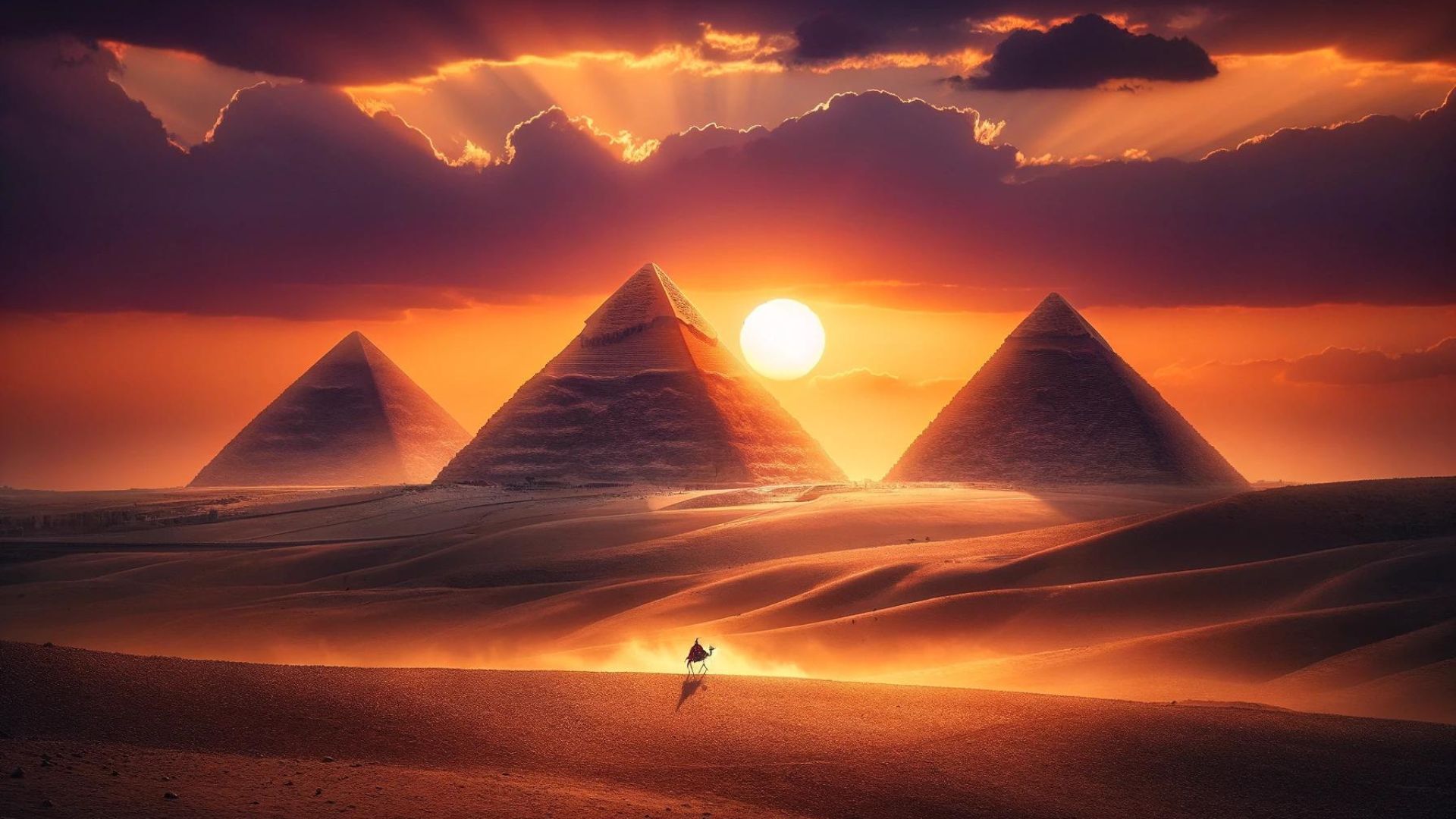The Timeless Enigma of the Pyramids
Standing on the windswept sands of the Egyptian desert, the Pyramids of Giza have fascinated and mystified people for millennia. These iconic structures, built over 4,500 years ago, continue to draw millions of visitors each year, sparking questions and theories about their creation, purpose, and the ancient civilization that built them. What is it about these pyramids that captivates the imagination? Why do they continue to challenge our understanding of ancient history?
The Marvel of Pyramid Construction
The Great Pyramid of Giza, also known as the Pyramid of Khufu, is the largest of the three pyramids and one of the Seven Wonders of the Ancient World. It was constructed during the reign of Pharaoh Khufu around 2560 BC. The sheer size and precision of the pyramid’s construction are astonishing, considering the technological limitations of the time.
How Were They Built?
The question of how the pyramids were built is perhaps the most enduring mystery. Imagine moving massive limestone blocks, each weighing an average of 2.5 tons, without modern machinery. Various theories have been proposed over the centuries, including the use of ramps, levers, and sledges. Recent discoveries suggest that a straight or zigzagging ramp might have been used to transport the stones to the higher levels. Water may have also played a role in reducing friction, allowing the stones to be moved more easily.
While the exact methods remain debated, the construction of the pyramids demonstrates the incredible ingenuity and organization of ancient Egyptian society. The ability to mobilize a large workforce, plan complex architectural designs, and execute them with precision is a testament to their advanced knowledge and skills.
The Purpose of the Pyramids
Tombs for Pharaohs
The primary purpose of the pyramids was to serve as monumental tombs for the pharaohs and their consorts. Ancient Egyptians believed in the afterlife and built these colossal structures to ensure the pharaoh’s safe passage and prosperity in the world beyond. The pyramids were filled with treasures, provisions, and religious texts to aid the deceased in their journey.
Symbol of Power
Beyond their funerary function, the pyramids symbolized the power and divine authority of the pharaohs. Building such immense structures required significant resources and manpower, underscoring the ruler’s control over his kingdom. The pyramids were not just burial sites; they were statements of political and spiritual dominance, designed to awe and inspire the living.
Mysteries and Theories
The pyramids are steeped in mystery, with numerous theories surrounding their construction and purpose. Some suggest that they were built with the help of extraterrestrials, citing the pyramids’ alignment with celestial bodies as evidence of advanced knowledge. Others believe that hidden chambers and secret tunnels still lie undiscovered within the stone structures, waiting to reveal more secrets.
While these theories capture the imagination, they often overshadow the remarkable achievements of the ancient Egyptians themselves. The pyramids stand as a testament to human creativity and determination, challenging us to appreciate the capabilities of our ancestors.
Why Understanding the Pyramids Matters
Understanding the Pyramids of Giza is crucial because they offer insights into ancient Egyptian culture, society, and technological prowess. By studying these monuments, we gain a deeper appreciation for the complexity and sophistication of early civilizations.
Relating to Real Life
The story of the pyramids is one of perseverance, innovation, and collaboration. It reminds us of the importance of vision and leadership in achieving great feats. In our own lives, we can draw inspiration from the Egyptians’ ability to overcome challenges and push the boundaries of what was thought possible.
Take Action: Embrace Curiosity and Discovery
Now that you’ve explored the mysteries of the Pyramids of Giza, take a moment to reflect on the awe-inspiring accomplishments of our ancestors. Consider how curiosity and a willingness to challenge the unknown can lead to remarkable discoveries in your own life. Embrace the spirit of exploration, whether by delving into history, pursuing a new hobby, or pushing yourself to learn something new. The pyramids remind us that the pursuit of knowledge and understanding is a timeless journey, one that can lead to extraordinary achievements.
By unraveling the mysteries of the Pyramids of Giza, we not only honor the legacy of ancient Egypt but also ignite our own passion for discovery. Let the pyramids inspire you to explore the unknown and uncover the wonders that await in your own life.
Expand Your Vocabulary
Understanding these key terms and expressions from the article will enhance your grasp of the topic and enrich your everyday language.
- Enigma
- Meaning: Something that is mysterious, puzzling, or difficult to understand.
- Context: The Pyramids of Giza are an enigma because their construction methods and purpose are still debated.
- Everyday Use: “The disappearance of the ancient city remains an enigma to historians.”
- Technological Limitations
- Meaning: The constraints or restrictions on what technology can achieve at a certain time.
- Context: The pyramids were built despite the technological limitations of ancient times.
- Everyday Use: “The invention was groundbreaking given the technological limitations of the era.”
- Ingenuity
- Meaning: The quality of being clever, original, and inventive.
- Context: The ancient Egyptians’ ingenuity allowed them to construct the massive pyramids.
- Everyday Use: “Her ingenuity in solving problems made her a valuable team member.”
- Divine Authority
- Meaning: The belief that a leader or ruler has been chosen or endorsed by a deity.
- Context: The pyramids symbolized the pharaoh’s divine authority and power.
- Everyday Use: “The king claimed his rule was supported by divine authority.”
- Alignment
- Meaning: The arrangement of things in a straight line or in correct relative positions.
- Context: The pyramids’ alignment with celestial bodies suggests advanced astronomical knowledge.
- Everyday Use: “Proper alignment of the wheels is crucial for the car’s performance.”
- Extraterrestrials
- Meaning: Beings or life forms that originate outside Earth.
- Context: Some theories suggest that extraterrestrials helped build the pyramids.
- Everyday Use: “Movies about extraterrestrials often explore themes of human-alien interaction.”
- Monumental
- Meaning: Great in importance, extent, or size; impressive or massive.
- Context: The pyramids are monumental structures, both in size and historical significance.
- Everyday Use: “Completing the project on time was a monumental achievement.”
- Testament
- Meaning: Evidence or proof of something’s existence, truth, or validity.
- Context: The pyramids stand as a testament to the capabilities of ancient Egyptians.
- Everyday Use: “Her success is a testament to her hard work and dedication.”
- Perseverance
- Meaning: The persistence in doing something despite difficulty or delay in achieving success.
- Context: The story of the pyramids is one of perseverance and determination.
- Everyday Use: “His perseverance paid off when he finally passed the exam.”
- Innovation
- Meaning: The introduction of new ideas, methods, or products.
- Context: The pyramids demonstrate innovation in architecture and engineering.
- Everyday Use: “The company’s innovation led to the development of a groundbreaking product.”
Let’s Talk
Consider these thought-provoking questions to deepen your understanding of the mysteries surrounding the Pyramids of Giza. Reflect on them personally, discuss them with friends and family, or share your thoughts in the comments section:
- What do you find most intriguing about the construction methods of the pyramids, and why?
- How does the concept of divine authority influence modern leadership and governance?
- In what ways can ancient ingenuity inspire modern technological advancements?
- How do you think the pyramids’ alignment with celestial bodies reflects the ancient Egyptians’ understanding of the universe?
- What role do you believe extraterrestrial theories play in our fascination with ancient structures?
- How can the perseverance of ancient civilizations in building monumental structures inspire us in our daily lives?
- What lessons can we learn from ancient innovations to apply to today’s challenges?
- How do the mysteries of the pyramids encourage us to explore other unknowns in history?
- Why is it important to appreciate and study ancient cultures and their achievements?
- How can we use the story of the pyramids to fuel our curiosity and drive for discovery in our own lives?
These questions can help you explore the rich history and enduring mysteries of the Pyramids of Giza, offering a deeper appreciation for the wonders of ancient Egypt and inspiring a lifelong quest for knowledge and understanding.










0 Comments